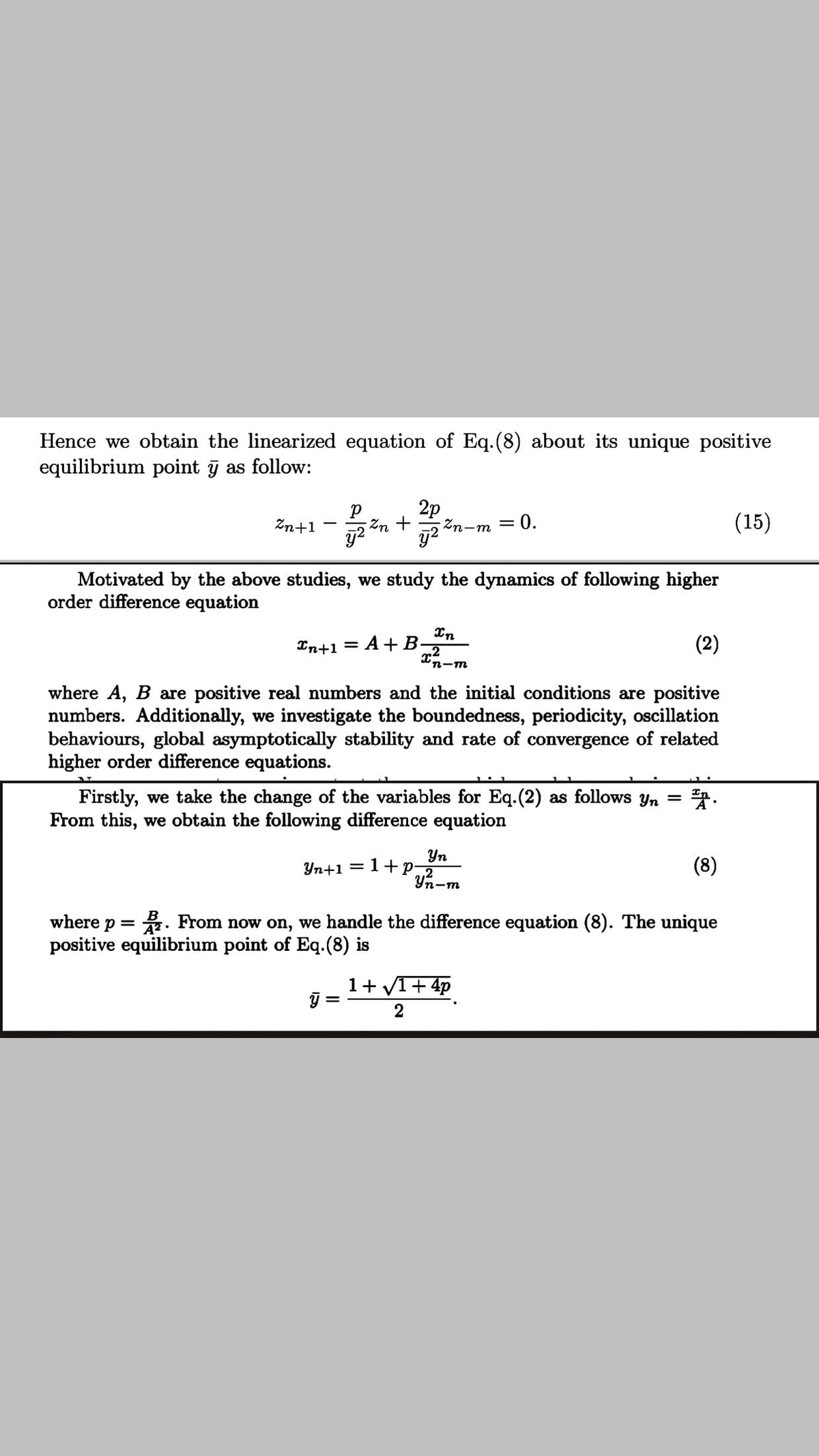a2 -α-p =0. So we get a = 1+/I+4p y + B which is a trivial solution. Now we deal with the other case such that m is odd. Now we apply Elsayed's new method for two periodic solution, see [16]. We have from Eq.(8)
a2 -α-p =0. So we get a = 1+/I+4p y + B which is a trivial solution. Now we deal with the other case such that m is odd. Now we apply Elsayed's new method for two periodic solution, see [16]. We have from Eq.(8)
Algebra & Trigonometry with Analytic Geometry
13th Edition
ISBN:9781133382119
Author:Swokowski
Publisher:Swokowski
Chapter9: Systems Of Equations And Inequalities
Section9.9: Properties Of Determinants
Problem 46E
Related questions
Question
Show me the steps of determine green and inf is here. Please i need the soluation

Transcribed Image Text:Hence we obtain the linearized equation of Eq.(8) about its unique positive
equilibrium point j as follow:
2p
--m = 0.
(15)
Zn+1
-
Motivated by the above studies, we study the dynamics of following higher
order difference equation
In
A+B
(2)
In+1
'n-m
where A, B are positive real numbers and the initial conditions are positive
numbers. Additionally, we investigate the boundedness, periodicity, oscillation
behaviours, global asymptotically stability and rate of convergence of related
higher order difference equations.
Firstly, we take the change of the variables for Eq.(2) as follows yn
From this, we obtain the following difference equation
Yn
Yn+1 = 1+p
Yn-m
(8)
where p = . From now on, we handle the difference equation (8). The unique
positive equilibrium point of Eq.(8) is
1+ 1+ 4p
2
![Theorem 6 Let {yn} be a positive solution of Eq. (8). Then Eq. (8) has no two
periodic solution.
Proof. We assume that there exist two periodic solution such that
α, β, α, β, . . .
where a and B are positive and distinct real numbers. We handle two cases for
the proof of Theorem. Firstly we consider a case such that m is even. We have
from Eq.(8)
р
a = 1+
= 1+
Hence we obtain that
— а — р %— 0.
1+y1+4p
B which is a trivial solution. Now we deal with
So we get a =
the other case such that m is odd. Now we apply Elsayed's new method for two
periodic solution, see [16]. We have from Eq.(8)
2
pB
a = 1+
pa
= 1+
4](/v2/_next/image?url=https%3A%2F%2Fcontent.bartleby.com%2Fqna-images%2Fquestion%2Fca1a5904-11c1-4e23-ad3b-bb585ae27c7a%2Fd8cd4e8f-1ca5-4981-9d77-597f2c9d4a53%2Fbjghm3_processed.jpeg&w=3840&q=75)
Transcribed Image Text:Theorem 6 Let {yn} be a positive solution of Eq. (8). Then Eq. (8) has no two
periodic solution.
Proof. We assume that there exist two periodic solution such that
α, β, α, β, . . .
where a and B are positive and distinct real numbers. We handle two cases for
the proof of Theorem. Firstly we consider a case such that m is even. We have
from Eq.(8)
р
a = 1+
= 1+
Hence we obtain that
— а — р %— 0.
1+y1+4p
B which is a trivial solution. Now we deal with
So we get a =
the other case such that m is odd. Now we apply Elsayed's new method for two
periodic solution, see [16]. We have from Eq.(8)
2
pB
a = 1+
pa
= 1+
4
Expert Solution
This question has been solved!
Explore an expertly crafted, step-by-step solution for a thorough understanding of key concepts.
Step by step
Solved in 2 steps with 1 images

Recommended textbooks for you

Algebra & Trigonometry with Analytic Geometry
Algebra
ISBN:
9781133382119
Author:
Swokowski
Publisher:
Cengage

Algebra & Trigonometry with Analytic Geometry
Algebra
ISBN:
9781133382119
Author:
Swokowski
Publisher:
Cengage